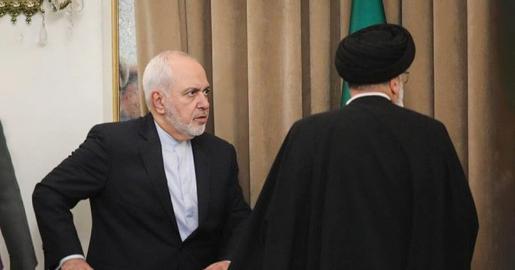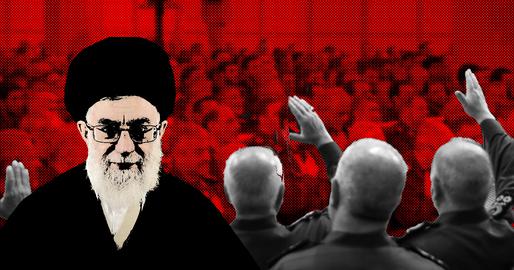
Iran and India share a profound historic association that penetrates language, culture and aesthetics, and offers diplomats from both countries perennial recourse. Persian, famously, was the language of the court of the Mughal Empire. The Indian Embassy in Tehran has published an extended essay that refers to “age old ties” and a “common linguistic and racial past.” According to the embassy, “It is believed that Indians and Iranians belonged to one single family before the beginning of the Indo-Aryan civilisation [sic] and lived together with a common language for many centuries in pasturelands of [the] Oxus valley in Central Asia.” The name Iran, it says, relates to the Sanskrit word arya, or “noble.”
Iran, too, is quick to pay respect to cultural ties. When Iran’s Foreign Minister Javad Zarif traveled to New Delhi in February to discuss the countries’ energy trade, infrastructure collaborations, and concerns about the future of Afghanistan, his delegation stopped at the Indian National Museum. At the museum, The Islamic Republic News Agency noted, officials found “invaluable paintings designed with Persian calligraphy and poems composed by Iranian poets.” IRNA cited Islamic cultural ties, too, noting that “A large portion of the artifacts...belong to the Islamic civilization and are naturally created by Muslim artists.”
India has the third-largest Muslim population in the world, the largest Muslim minority, and the third largest Shia Muslim population.
Yet religious ties have occasionally figured, too, in impolitic moments. In an infamous informal diplomatic encounter, an Iranian official is supposed to have objected to India’s amenability to the United States, remarking, “Your qibla is Washington.”
From Cold War Rivals to “Natural Allies”
Throughout the 1950s and 1960s, Mohammad Reza Pahlavi mistrusted India, in part because it supported Egyptian President Gamal Abdel Nasser, whose pan-Arab ideology threatened Middle Eastern monarchies. The Shah pursued close relations with Pakistan at India’s expense. Although the Iran-Pakistan relationship waned before the Iranian Revolution of 1979, Pahlavi officials’ mistrust of India was such that, even in 1978, government propagandists attacked Ruhollah Khomeini in an infamous Ettela’at article by linking him to India and, by extension, to colonial history and British paymasters.
India, for its part, met the Iranian Revolution with surprise and reservation. “They didn’t look favorably on a radical Islamist regime coming to power at that point,” says Shashank Joshi, PhD candidate at Harvard University’s Department of Government and Research Fellow at the Royal United Services Institute. “India had had a somewhat shaky relationship with the Shah but it was getting better by the late 70s. They pragmatically dealt with Iran, but they [also] had pretty good relations with Saddam Hussein’s Iraq in the 1980s and even through the first Gulf War. [During that period] the relationship with the revolutionary regime was somewhat strained.”
Today, by contrast, India and Iran share diverse interests, from the energy trade to regional security, and cooperate on infrastructure projects related to both, such as Iran’s deep-water port at Chabahar. India’s military relationship with Israel and its willingness to back Western powers at the International Atomic Energy Agency may cause Iran discomfort, but equally, says Sumitha Narayanan Kutty, a journalist and South Asia analyst and communications consultant at the World Resources Institute, “Iran is key to India’s vision of an independent foreign policy.” On a popular level, she says, “Indians have this baggage of anti-colonialism, anti-imperialism. There’s a whole part of the lay population which sort of admires Iran for standing up against the U.S. and western interests.”
The United States, Joshi says, finds India’s relationship with Iran to be an irritant. Wikileaks cables, he says, revealed U.S. observations about Iran’s attempts to appeal to Indian newspaper editors over its nuclear program. The U.S. sees India’s commercial ties with Iran, too, as an obstacle to its attempts to pressure Iran through multilateral sanctions. “Over the past 10 years,” Joshi says, “the U.S. has made a lot of efforts to persuade India that its future does not lie with Tehran and that it should abide by U.S. sanctions legislation.” Nevertheless, he says, India has made an effort to keep a foot in the Iranian camp, even if it has “given way in crucial areas” such as voting against Iran at the IAEA.
India, says Azadeh Pourzand, a former Senior Researcher at the Indian think tank Gateway House, will not compromise any of its interests for Iran. “India is good friends with Iran’s enemies, Saudi Arabia, the U.S., and Israel. But it’s a balancing act. India really does like to use Iran’s friendship as a signifier of its emerging leadership role in [its] region.”
India perceives Iran as a permanent regional player with overlapping security interests. “I think Indian elites subscribe to the theory that U.S. power is on the wane,” Joshi says. India, he says, sees Iran as a natural strategic partner, a natural ally against Sunni fundamentalism, a potential ally against Pakistan, and as a natural ally in Afghanistan, since both parties have supported anti-Taliban forces. “That perception of Iran is held in reserve. Paradoxically, the more that U.S.-Iran ties improve, the more liberated the government of India will feel to improve ties to Iran after some years in which it felt inhibited by U.S. pressure.”
(Perceived) common interests in Afghanistan
From an Indian perspective, says Pourzand, both countries are invested in the future of Afghanistan, although India focuses on “the softer side of things”, contributing knowledge and resources. “They see Iran as being on board with them except [with regard to] the presence of NATO, which India supports and Iran doesn’t.” Nevertheless, says Kutty, “The primary motivation for both India and Iran is the security of Afghanistan after the ISAF troops withdraw. Both countries are afraid of what lies between them—Pakistan, and how [its] exporting of terror affects Afghanistan’s future.”
Joshi is skeptical of India’s optimism about Iran’s role in Afghanistan. “I stress perceived common interests,” he says. “India sees Iran as an enduring ally against the Taliban resurgence [because] they’re going to be around when the Americans and the Brits and ISAF are not. This is a neighboring country that will have enduring influence in the Western provinces of Afghanistan amongst its Persian-speaking allies.” But while Iran opposes a wholesale return of the Taliban, Joshi says, “The Indians tend to overlook the extent to which the Iranians are pragmatic.” Iran, he says, has not been above supporting the insurgency in Afghanistan over the past 10 years, and takes “a much more accommodating, pragmatic stance within Afghanistan than the Indians would like to think.”
India and Iran cooperate on several infrastructure projects, notably Iran’s port at Chabahar, in which India has invested in in hopes of bypassing Pakistan and improving its access to Afghanistan and Central Asia. But Joshi says that despite India’s enthusiasm about these projects, progress has been slow and the Indian government has not invested resources commensurate with the potential that they insist the relationship with Iran holds. “Some of that is due to American pressure, [but there is also] a sense that [while] India and Iran are seen as allies in a broad sense, when you draw down, it doesn’t always add up to much,” he says.
An energy trade with immense potential
India is the world’s fourth largest energy consumer and draws three quarters of its oil supplies from abroad. Iran is well placed to help meet those needs, but Western sanctions directed at its nuclear program have forced India to reduce reliance on its neighbor. The November 24th 2013 interim nuclear deal between Iran and the P5+1 powers obliges Iran to keep exports at “current volumes,” and the United States continues to pressure India to reduce Iranian oil imports.
Under the Ahmadinejad government, Iran agreed to accept its entire payment for oil in rupees, a move that led to a substantial increase in Indian exports to Iran, but last September, Iran’s new oil minister, Bijan Zangeneh, asked India to renegotiate the terms, so that Iran would accept only 45 per cent of payments in rupees, preferring majority payment in Euros.
Before the 2012 round of sanctions, says Dr. Sara Vakhshouri, president to the consulting firm SVB Energy International, Iran was the second-largest supplier of crude oil to India, and India was Iran’s third largest customer overall, after China and Japan, importing 13 per cent of all Iranian oil exports. While Iran used to meet around 16 per cent of India’s oil needs, she says, Iranian oil now constitutes only around 6 per cent of Indian oil imports, although numbers have recently increased. “Although there is no guarantee that India is going to import the same amount of oil from Iran [as it did before],” Vakhshouri says, “this indicates that Iran could easily gain back its market in India in the event of the further relaxing of sanctions.”
An election and a new relationship?
Indian voters have yet to decide on new leadership in elections whose results officials will announce on May 16th, but there is little sense that Iran favors a particular party, Joshi says. “The striking thing about Indian foreign policy is its continuity.” While the ruling Congress Party may be perceived as having allowed relations with Iran to drift, he says, a ruling Bharatiya Janata Party government would hardly have behaved differently if it had been in power.
Many Indians, however, regard BJP leader Narendra Modi with alarm, due in part to allegations that he encouraged mob violence in Gujarat in 2002 that led to the deaths of over 1,000 people, most of whom were Muslims. Prominent Indians, including Anish Kapoor and Salman Rushdie, have signed an open letter arguing that Modi’s election would “bode ill” for India.
“The BJP, the anti-Islam history, is a definitely a challenge, [for Iran]” says Pourzand. How much Iran will want to “play the big Muslim brother in the region” she says, remains unclear. The last BJP government that ruled from 1998 to 2004, Kutty says, managed to balance strategic pacts with Iran, Saudi Arabia, and Israel. Noting Modi’s controversial past, Kutty says, “I’m sure Muslim nations have been wary [of him]. He’s never really dealt with governments in the Middle East.” While she notes that India’s relations with the United States are a matter of “bipartisan consensus” in Indian politics, she says, “Modi has been a very interesting man—pandering to his crowd, a very anti-Western, anti-U.S., nationalistic [constituency]—who might just be appreciated by the Iranians.”
visit the accountability section
In this section of Iran Wire, you can contact the officials and launch your campaign for various problems

























comments